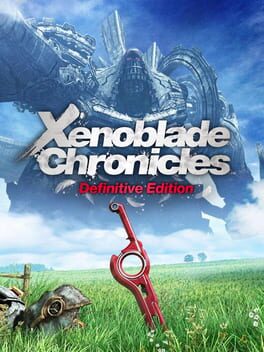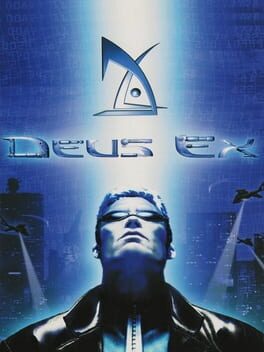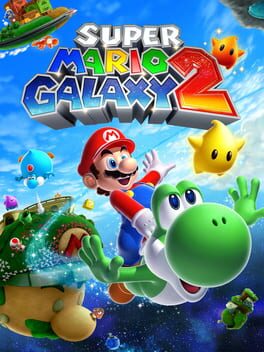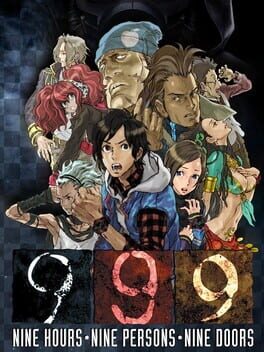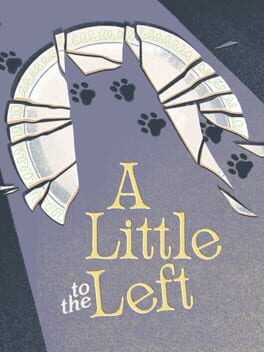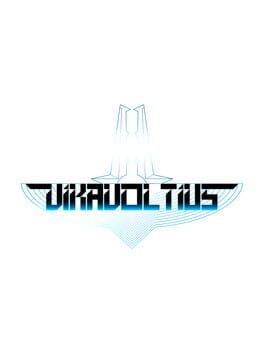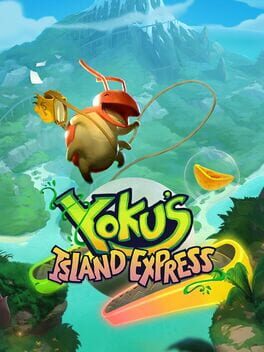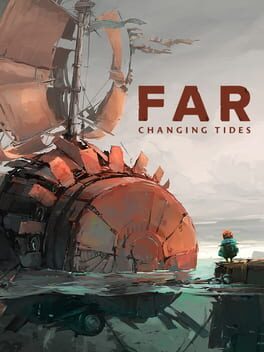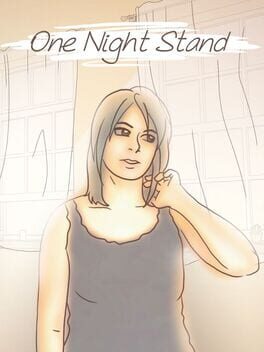Psientologist
Bio
I've been playing games for far too long
Give me an interesting flawed games over perfectly refined games that add nothing new.
Using this space to rely less on my sieve brain and also to put some thoughts into words on the things I am playing old and new.
I've been playing games for far too long
Give me an interesting flawed games over perfectly refined games that add nothing new.
Using this space to rely less on my sieve brain and also to put some thoughts into words on the things I am playing old and new.
Badges

Adored
Gained 300+ total review likes

GOTY '23
Participated in the 2023 Game of the Year Event

Shreked
Found the secret ogre page

Pinged
Mentioned by another user

Loved
Gained 100+ total review likes

Well Written
Gained 10+ likes on a single review

2 Years of Service
Being part of the Backloggd community for 2 years

GOTY '22
Participated in the 2022 Game of the Year Event

Gone Gold
Received 5+ likes on a review while featured on the front page

N00b
Played 100+ games

Popular
Gained 15+ followers

Donor
Liked 50+ reviews / lists

Liked
Gained 10+ total review likes

Roadtrip
Voted for at least 3 features on the roadmap

Best Friends
Become mutual friends with at least 3 others

Noticed
Gained 3+ followers

GOTY '21
Participated in the 2021 Game of the Year Event
Favorite Games
229
Total Games Played
018
Played in 2024
031
Games Backloggd
Recently Played See More
Recently Reviewed See More
Cosy, wholesome, zen. I don’t outright hate these terms when discussing video games but as discussed on The Computer Game Show trying to use those terms as a genre title feels, incorrect, possibly disingenuous.
Horror is a genre, not “scary”, the decision of what something feels like is up to its audience.
It may sound redundant but acting as if cosy is a genre is the equivalent to filing a game under “fun”.
I have definitely used these words to describe games in the past. I am a fan of having games that I can relax with, zone out a little and not feel pressured or even stressed.
A Little to the Left aims for a feeling of being cosy, simple and just nice. Organising varying objects into a tidy manner as a simple puzzle, while along the way introducing a long-haired white cat to add to the everyday wholesome feeling the game is aiming for, using this cat as a game mechanic to either mess with your tidying or as a theme to the puzzles.
I love cats, but I feel that, let’s just call them “cat people”, end up elevating a lot of things that include cats to a pedestal they do not deserve.
This again just added to a feeling which may make me sound miserable, of being told I should like something which had me push back against it.
I will decide whether the game is wholesome, not the game itself.
As far as the organising and puzzles, A Little to the Left fails to do either in a way that really landed with me.
In terms of organising, the feeling is enjoyable for a moment and quickly repetitive. These items other than feeling quite “everyday” don’t really do anything else but act as icons, there is no story within them unlike Unpacking - the game I would say really pushed this subgenre.
The puzzles again are repetitive, organise by size, organise in a colour gradient, make something symmetrical, there is really not much else to them other than this.
Once you understand the game’s language, what it decides is organised, you can solve each puzzle within seconds, maybe replaying for different solutions but quickly moving on.
Another issue with the puzzles themselves is the interactions of simply picking up and putting stuff down never feels precise enough and also doesn’t feel marked out enough to do quickly.
Many times I would have items in the right order but the game had me fiddle with the items until lined up perfectly and that in my eyes, doesn’t feel relaxed or cosy, it feels annoying and like busy work. I will also add here that one puzzle the game would not allow me to solve even though I had everything correct (I ended up using the hint and then guides to check) but because it wouldn’t progress I spent minutes fiddling for no gain.
Sadly repetition is the biggest flaw of A Little to the Left and the finale really ramps this to a stage where I found myself saying “I don’t care about this cat”.
Perhaps there is an argument that I should have played this game in shorter bursts and to a degree I agree with that assessment. However, this further enforces the final point I’d like to make about this game. It’s in the wrong format.
This title is on PC and all the modern consoles, and outside of the Switch and maybe the Steam Deck I don’t think this fits. It has “mobile game” written all over it and whilst I don’t intend that to be an insult it does make it feel wrong playing on a bigger screen.
Multiple stages with tiny puzzles and little in the way of connective thread throughout them just reminds me of the classic games on iOS such as Angry Birds, Cut the Rope or even Monument Valley although that feels more narratively driven.
A Little to the Left is a Little Disappointing.
Horror is a genre, not “scary”, the decision of what something feels like is up to its audience.
It may sound redundant but acting as if cosy is a genre is the equivalent to filing a game under “fun”.
I have definitely used these words to describe games in the past. I am a fan of having games that I can relax with, zone out a little and not feel pressured or even stressed.
A Little to the Left aims for a feeling of being cosy, simple and just nice. Organising varying objects into a tidy manner as a simple puzzle, while along the way introducing a long-haired white cat to add to the everyday wholesome feeling the game is aiming for, using this cat as a game mechanic to either mess with your tidying or as a theme to the puzzles.
I love cats, but I feel that, let’s just call them “cat people”, end up elevating a lot of things that include cats to a pedestal they do not deserve.
This again just added to a feeling which may make me sound miserable, of being told I should like something which had me push back against it.
I will decide whether the game is wholesome, not the game itself.
As far as the organising and puzzles, A Little to the Left fails to do either in a way that really landed with me.
In terms of organising, the feeling is enjoyable for a moment and quickly repetitive. These items other than feeling quite “everyday” don’t really do anything else but act as icons, there is no story within them unlike Unpacking - the game I would say really pushed this subgenre.
The puzzles again are repetitive, organise by size, organise in a colour gradient, make something symmetrical, there is really not much else to them other than this.
Once you understand the game’s language, what it decides is organised, you can solve each puzzle within seconds, maybe replaying for different solutions but quickly moving on.
Another issue with the puzzles themselves is the interactions of simply picking up and putting stuff down never feels precise enough and also doesn’t feel marked out enough to do quickly.
Many times I would have items in the right order but the game had me fiddle with the items until lined up perfectly and that in my eyes, doesn’t feel relaxed or cosy, it feels annoying and like busy work. I will also add here that one puzzle the game would not allow me to solve even though I had everything correct (I ended up using the hint and then guides to check) but because it wouldn’t progress I spent minutes fiddling for no gain.
Sadly repetition is the biggest flaw of A Little to the Left and the finale really ramps this to a stage where I found myself saying “I don’t care about this cat”.
Perhaps there is an argument that I should have played this game in shorter bursts and to a degree I agree with that assessment. However, this further enforces the final point I’d like to make about this game. It’s in the wrong format.
This title is on PC and all the modern consoles, and outside of the Switch and maybe the Steam Deck I don’t think this fits. It has “mobile game” written all over it and whilst I don’t intend that to be an insult it does make it feel wrong playing on a bigger screen.
Multiple stages with tiny puzzles and little in the way of connective thread throughout them just reminds me of the classic games on iOS such as Angry Birds, Cut the Rope or even Monument Valley although that feels more narratively driven.
A Little to the Left is a Little Disappointing.
After I recently played VideoVerse and also having listened to them on The Back Page Podcast I knew that I could trust Lucy Blundell’s writing.
In a way this game has passed me by but I will also admit here that the title conjured up something in me that put me off. It wasn’t thinking about one night stands themselves but when videogames attempt to be sexy, more often than not it’s a miss, sometimes cringe and potentially offensive.
This title is not.
One Night Stand is a very short experience but one that encourages you to try it again to discover the different outcomes your decisions can make, surprising revelations and ultimately rack up a selection of different endings.
Each of these are full of wonderful writing, full of realistic and relatable notes. If there is any moment of cringing it is something you have opted to see. There are very few characters involved as you’d expect and the main being the woman you have found yourself awake next to - even their name is a spoiler.
She can be funny, sweet or even cold but again, feels real.
Replaying the story you can skip text and the options are quite diverse considering the, almost, one room setting. These retries also gave me a light feeling of a good detective game, discovering evidence and piecing separate dialogue together with a mental red string that not only painted a much fuller picture than I could visually see but one with some good “ah ha” and “oh shit!” moments.
Speaking of what I could see visually, I love the art style. A simple pencil sketch looking feel that gave me Hotel Dusk vibes. Great facial expressions from your one-night stand and lots of brilliant details within the room that again enhances the feeling that this story is not purely fiction.
In the end however, I feel a little conflicted about this title. It is smartly written, beautifully presented and executed well but whilst I do not dislike short games playing the same short game over and over made me feel contradictory views of wanting more but also finding getting the last few endings more of something like busy work than the mild detective feel I had gotten earlier.
An argument could be made to just get a few endings and put it down when you feel you’ve seen enough variation, but having a screen full of blank squares you know you can fill, boxes you can check - it’s hard to do that when you know the effort, at least in terms of time, is so low.
I enjoyed my initial ending with this game, I played it “as if” it was me and was pleased. It made me want to see more of the world and that is good.
I enjoyed doing things I would definitely not, going for things I felt were possibly the stupidest decisions and having a good laugh at them.
The writing carries this game and it is definitely worth a play considering it's about the price of a coffee - ultimately I’m just not sure that this format of short with a dozen endings is my vibe compared to long with a few endings, but that is fine. There is space for all types of storytelling and I’m happy that we get to experience them.
In a way this game has passed me by but I will also admit here that the title conjured up something in me that put me off. It wasn’t thinking about one night stands themselves but when videogames attempt to be sexy, more often than not it’s a miss, sometimes cringe and potentially offensive.
This title is not.
One Night Stand is a very short experience but one that encourages you to try it again to discover the different outcomes your decisions can make, surprising revelations and ultimately rack up a selection of different endings.
Each of these are full of wonderful writing, full of realistic and relatable notes. If there is any moment of cringing it is something you have opted to see. There are very few characters involved as you’d expect and the main being the woman you have found yourself awake next to - even their name is a spoiler.
She can be funny, sweet or even cold but again, feels real.
Replaying the story you can skip text and the options are quite diverse considering the, almost, one room setting. These retries also gave me a light feeling of a good detective game, discovering evidence and piecing separate dialogue together with a mental red string that not only painted a much fuller picture than I could visually see but one with some good “ah ha” and “oh shit!” moments.
Speaking of what I could see visually, I love the art style. A simple pencil sketch looking feel that gave me Hotel Dusk vibes. Great facial expressions from your one-night stand and lots of brilliant details within the room that again enhances the feeling that this story is not purely fiction.
In the end however, I feel a little conflicted about this title. It is smartly written, beautifully presented and executed well but whilst I do not dislike short games playing the same short game over and over made me feel contradictory views of wanting more but also finding getting the last few endings more of something like busy work than the mild detective feel I had gotten earlier.
An argument could be made to just get a few endings and put it down when you feel you’ve seen enough variation, but having a screen full of blank squares you know you can fill, boxes you can check - it’s hard to do that when you know the effort, at least in terms of time, is so low.
I enjoyed my initial ending with this game, I played it “as if” it was me and was pleased. It made me want to see more of the world and that is good.
I enjoyed doing things I would definitely not, going for things I felt were possibly the stupidest decisions and having a good laugh at them.
The writing carries this game and it is definitely worth a play considering it's about the price of a coffee - ultimately I’m just not sure that this format of short with a dozen endings is my vibe compared to long with a few endings, but that is fine. There is space for all types of storytelling and I’m happy that we get to experience them.
Bigger doesn’t always mean better. A cliché to kick off the review but it’s a fitting single line summary of how I feel when speaking about Lone Sails sequel.
FAR: Lone Sails was a special experience for me, both in just watching it streamed as mentioned in my review of that title and playing it for myself.
To this day I still play the OST while writing journals for my education, and occasionally depending on mood and my writing subject the music takes me to a place that I find myself getting very glassy eyed.
To hit that high again with a sequel was probably an impossibility and it pains me to say that in fact, it was.
Changing Tides is still a fantastic game in its own right, cleverly keeping the formula of controlling a vehicle, exploring an interesting unknown land and going on a journey, whilst changing up the types of scenery and the vehicular partner enough to be fresh.
Every review I write may be the first of mine that someone has read and I can only apologise if I lack the words for explaining this game, but rather than repeat myself I feel that as important as it is to play these games in order, it is to read my thoughts on them.
Changing Tides, rather than having a “car” like the first, you have more of a “boat”.
You’re still collecting junk which can be used for fuel or saved if you like, you still have nature as a pushing force as well as engineering and the places it goes in terms of travel are arguably more interesting and diverse.
However again, bigger doesn’t necessarily mean better.
I found this vehicle a lot more hassle, this not only gives some unwanted friction but doesn’t help build the bond I found myself having in the first FAR title.
What also doesn’t really help with this is I felt like I spent much more time away from my motorised-mate in this game than I did the first.
Swimming beneath the sea and doing some mild puzzles and platforming isn’t bad, but it isn’t great either. Puzzles are predictable, some reveals are astounding and that scale is one place where Changing Tides does trump Lone Sails but the emotional connection to the journey feeling less didn’t help those moments stick.
Joel Schoch returns to play another beautiful, lonely, sometimes sad and sometimes uplifting OST and much like Lone Sails I can see myself listening to this when writing in the future.
An issue though, not of the music itself, is the weird lack of it in places.
There are points where silence is powerful but it felt too often, almost as if maybe the game was broken.
FAR: Changing Tides may not hold a place in my heart like Lone Sails did, but I had a lovely time and the ending, which I will not spoil, will at least be something that does stick with me. Powerful stuff.
Changing Tides is worth your time, but sadly it does almost everything worse than its predecessor, not terribly so but enough that it loses some magic.
I can only theorise that perhaps the four year gap between games gave the studio time to overthink what they wanted to do, what they wanted to say and what they were making.
I will take a FAR 3 though. Please and thank you.
FAR: Lone Sails was a special experience for me, both in just watching it streamed as mentioned in my review of that title and playing it for myself.
To this day I still play the OST while writing journals for my education, and occasionally depending on mood and my writing subject the music takes me to a place that I find myself getting very glassy eyed.
To hit that high again with a sequel was probably an impossibility and it pains me to say that in fact, it was.
Changing Tides is still a fantastic game in its own right, cleverly keeping the formula of controlling a vehicle, exploring an interesting unknown land and going on a journey, whilst changing up the types of scenery and the vehicular partner enough to be fresh.
Every review I write may be the first of mine that someone has read and I can only apologise if I lack the words for explaining this game, but rather than repeat myself I feel that as important as it is to play these games in order, it is to read my thoughts on them.
Changing Tides, rather than having a “car” like the first, you have more of a “boat”.
You’re still collecting junk which can be used for fuel or saved if you like, you still have nature as a pushing force as well as engineering and the places it goes in terms of travel are arguably more interesting and diverse.
However again, bigger doesn’t necessarily mean better.
I found this vehicle a lot more hassle, this not only gives some unwanted friction but doesn’t help build the bond I found myself having in the first FAR title.
What also doesn’t really help with this is I felt like I spent much more time away from my motorised-mate in this game than I did the first.
Swimming beneath the sea and doing some mild puzzles and platforming isn’t bad, but it isn’t great either. Puzzles are predictable, some reveals are astounding and that scale is one place where Changing Tides does trump Lone Sails but the emotional connection to the journey feeling less didn’t help those moments stick.
Joel Schoch returns to play another beautiful, lonely, sometimes sad and sometimes uplifting OST and much like Lone Sails I can see myself listening to this when writing in the future.
An issue though, not of the music itself, is the weird lack of it in places.
There are points where silence is powerful but it felt too often, almost as if maybe the game was broken.
FAR: Changing Tides may not hold a place in my heart like Lone Sails did, but I had a lovely time and the ending, which I will not spoil, will at least be something that does stick with me. Powerful stuff.
Changing Tides is worth your time, but sadly it does almost everything worse than its predecessor, not terribly so but enough that it loses some magic.
I can only theorise that perhaps the four year gap between games gave the studio time to overthink what they wanted to do, what they wanted to say and what they were making.
I will take a FAR 3 though. Please and thank you.

